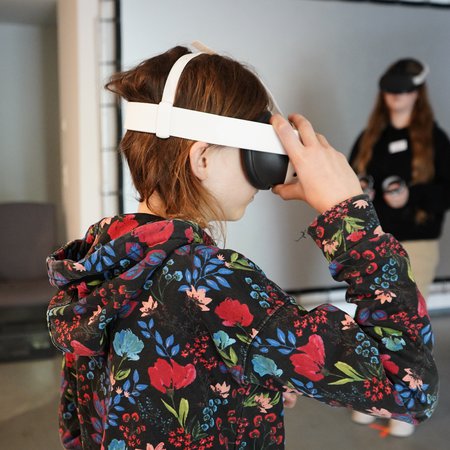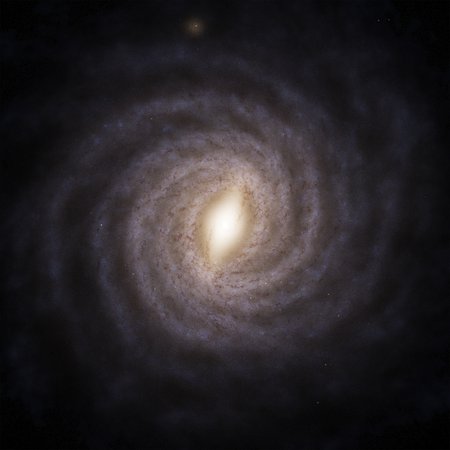Next generation astronomical survey to map the entire sky

This artist's impression shows a cutaway view of the parts of the Universe that SDSS-V will study. SDSS-V will study millions of stars to create a map of the entire Milky Way. Farther out, the survey will get the most detailed view yet of the largest nearby galaxies like Andromeda in the Northern hemisphere and the Large Magellanic Cloud in the Southern hemisphere. Even farther out, the survey will measure quasars, bright points of light powered by matter falling into giant black holes.
Credit: Robin Dienel/Carnegie Institution for Science/SDSSThe Alfred P. Sloan Foundation will award a $16 million grant for the next generation of the Sloan Digital Sky Survey (SDSS-V). The grant will kickstart a groundbreaking all-sky spectroscopic survey for a next wave of discovery, anticipated to start in 2020.
The Leibniz Institute for Astrophysics Potsdam (AIP) is an associate member of SDSS with usage rights for researchers and graduate students. “AIP’s main engagement is in the APOGEE survey, which complements the RAVE survey led by AIP,” says Prof. Dr. Matthias Steinmetz, AIP’s lead scientist in the SDSS collaboration. “With these surveys we have been able to dissect the Milky Way Galaxy and thus gain new insights in its structure and formation history.”
In the tradition of previous Sloan Surveys, SDSS-V is committed to making its data publicly available in a format that is helpful to a broad range of users, from the youngest students to both amateur and professional astronomers.
The survey operates out of both Apache Point Observatory in New Mexico, home of the survey’s original 2.5-meter telescope, and Carnegie’s Las Campanas Observatory in Chile, where it uses Carnegie’s du Pont telescope. SDSS-V will make use of both optical and infrared spectroscopy, to observe not only in two hemispheres, but also at two wavelengths of light.
It will take advantage of the recently installed second APOGEE spectrograph on Carnegie’s du Pont telescope. Both it and its twin on Apache Point penetrate the dust in our Galaxy that confounds optical spectrographs to obtain high-resolution spectra for hundreds of stars at infrared wavelengths. In the optical wavelengths, the survey’s twin BOSS spectrographs can each obtain simultaneous spectra for 500 stars and quasars. What’s more, a newly envisioned pair of Integral Field Unit spectrographs can each obtain nearly 2,000 spectra contiguously across objects in the sky.
SDSS-V will consist of three projects, each mapping different components of the universe: The Milky Way Mapper, the Black Hole Mapper and the Local Volume Mapper. The first Mapper focuses on the formation of the Milky Way and its stars and planets. The second will study the formation, growth, and ultimate sizes of the supermassive black holes that lurk at the centers of galaxies. The Local Volume Mapper will create the first complete spectroscopic maps of the most-iconic nearby galaxies. “These projects will be very complementary to the 4MOST science, of which AIP is a lead,” adds Dr. Cristina Chiappini who represents the AIP in the Collaboration Council.
SDSS is managed by the astrophysical research consortium for the Participating Institutions of the SDSS Collaboration. Funding for the Sloan Digital Sky Survey IV has been provided by the Alfred P. Sloan Foundation, the U.S. Department of Energy Office of Science, and the participating institutions. The project’s fifth generation is building its consortium, but already has support from 18 institutions including the Leibniz Institute for Astrophysics Potsdam.
Science contacts:
Prof. Dr. Matthias Steinmetz, +49 331-7499 801, msteinmetz@aip.de
Dr. Cristina Chiappini, +49 331 7499-454, cristina.chiappini@aip.de
Press contact: Katrin Albaum, +49 331-7499 803, presse@aip.de
Further information
Original press release by the Sloan Digital Sky Survey:
www.sdss.org/press-releases/sdss5
The SDSS web site:
www.sdss.org

This artist's impression shows a cutaway view of the parts of the Universe that SDSS-V will study. SDSS-V will study millions of stars to create a map of the entire Milky Way. Farther out, the survey will get the most detailed view yet of the largest nearby galaxies like Andromeda in the Northern hemisphere and the Large Magellanic Cloud in the Southern hemisphere. Even farther out, the survey will measure quasars, bright points of light powered by matter falling into giant black holes.
Credit: Robin Dienel/Carnegie Institution for Science/SDSSThe Alfred P. Sloan Foundation will award a $16 million grant for the next generation of the Sloan Digital Sky Survey (SDSS-V). The grant will kickstart a groundbreaking all-sky spectroscopic survey for a next wave of discovery, anticipated to start in 2020.
The Leibniz Institute for Astrophysics Potsdam (AIP) is an associate member of SDSS with usage rights for researchers and graduate students. “AIP’s main engagement is in the APOGEE survey, which complements the RAVE survey led by AIP,” says Prof. Dr. Matthias Steinmetz, AIP’s lead scientist in the SDSS collaboration. “With these surveys we have been able to dissect the Milky Way Galaxy and thus gain new insights in its structure and formation history.”
In the tradition of previous Sloan Surveys, SDSS-V is committed to making its data publicly available in a format that is helpful to a broad range of users, from the youngest students to both amateur and professional astronomers.
The survey operates out of both Apache Point Observatory in New Mexico, home of the survey’s original 2.5-meter telescope, and Carnegie’s Las Campanas Observatory in Chile, where it uses Carnegie’s du Pont telescope. SDSS-V will make use of both optical and infrared spectroscopy, to observe not only in two hemispheres, but also at two wavelengths of light.
It will take advantage of the recently installed second APOGEE spectrograph on Carnegie’s du Pont telescope. Both it and its twin on Apache Point penetrate the dust in our Galaxy that confounds optical spectrographs to obtain high-resolution spectra for hundreds of stars at infrared wavelengths. In the optical wavelengths, the survey’s twin BOSS spectrographs can each obtain simultaneous spectra for 500 stars and quasars. What’s more, a newly envisioned pair of Integral Field Unit spectrographs can each obtain nearly 2,000 spectra contiguously across objects in the sky.
SDSS-V will consist of three projects, each mapping different components of the universe: The Milky Way Mapper, the Black Hole Mapper and the Local Volume Mapper. The first Mapper focuses on the formation of the Milky Way and its stars and planets. The second will study the formation, growth, and ultimate sizes of the supermassive black holes that lurk at the centers of galaxies. The Local Volume Mapper will create the first complete spectroscopic maps of the most-iconic nearby galaxies. “These projects will be very complementary to the 4MOST science, of which AIP is a lead,” adds Dr. Cristina Chiappini who represents the AIP in the Collaboration Council.
SDSS is managed by the astrophysical research consortium for the Participating Institutions of the SDSS Collaboration. Funding for the Sloan Digital Sky Survey IV has been provided by the Alfred P. Sloan Foundation, the U.S. Department of Energy Office of Science, and the participating institutions. The project’s fifth generation is building its consortium, but already has support from 18 institutions including the Leibniz Institute for Astrophysics Potsdam.
Science contacts:
Prof. Dr. Matthias Steinmetz, +49 331-7499 801, msteinmetz@aip.de
Dr. Cristina Chiappini, +49 331 7499-454, cristina.chiappini@aip.de
Press contact: Katrin Albaum, +49 331-7499 803, presse@aip.de
Further information
Original press release by the Sloan Digital Sky Survey:
www.sdss.org/press-releases/sdss5
The SDSS web site:
www.sdss.org
Images
This artist's impression shows a cutaway view of the parts of the Universe that SDSS-V will study. SDSS-V will study millions of stars to create a map of the entire Milky Way. Farther out, the survey will get the most detailed view yet of the largest nearby galaxies like Andromeda in the Northern hemisphere and the Large Magellanic Cloud in the Southern hemisphere. Even farther out, the survey will measure quasars, bright points of light powered by matter falling into giant black holes.



